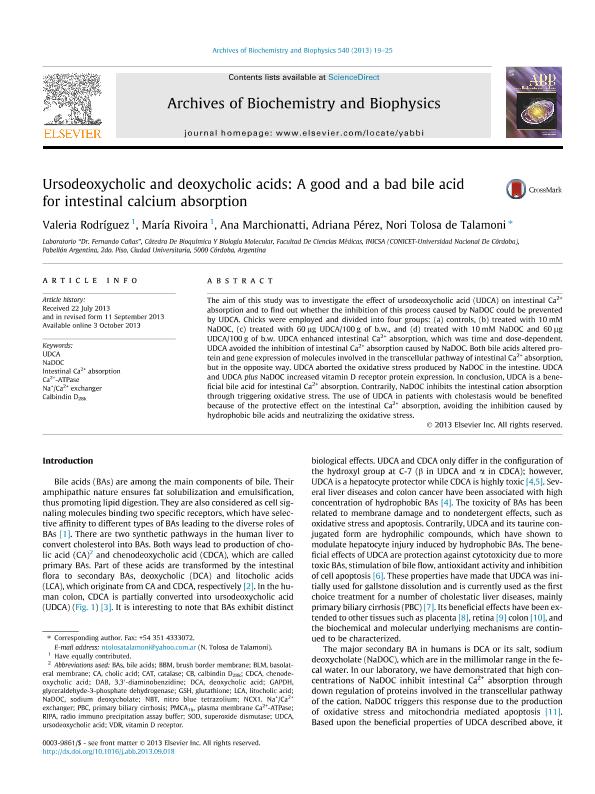Artículo
Ursodeoxycholic and deoxycholic acids: A good and a bad bile acid for intestinal calcium absorption
Rodriguez, Valeria Andrea ; Rivoira, María Angélica; Marchionatti, Ana María; del Valle Perez, Adriana; Tolosa, Nori Graciela
; Rivoira, María Angélica; Marchionatti, Ana María; del Valle Perez, Adriana; Tolosa, Nori Graciela
 ; Rivoira, María Angélica; Marchionatti, Ana María; del Valle Perez, Adriana; Tolosa, Nori Graciela
; Rivoira, María Angélica; Marchionatti, Ana María; del Valle Perez, Adriana; Tolosa, Nori Graciela
Fecha de publicación:
12/2013
Editorial:
Elsevier Science Inc
Revista:
Archives Of Biochemistry And Biophysics
ISSN:
0003-9861
Idioma:
Inglés
Tipo de recurso:
Artículo publicado
Clasificación temática:
Resumen
The aim of this study was to investigate the effect of ursodeoxycholic acid (UDCA) on intestinal Ca2+ absorption and to find out whether the inhibition of this process caused by NaDOC could be prevented by UDCA. Chicks were employed and divided into four groups: (a) controls, (b) treated with 10 mM NaDOC, (c) treated with 60 lg UDCA/100 g of b.w., and (d) treated with 10 mM NaDOC and 60 lg UDCA/100 g of b.w. UDCA enhanced intestinal Ca2+ absorption, which was time and dose-dependent. UDCA avoided the inhibition of intestinal Ca2+ absorption caused by NaDOC. Both bile acids altered protein and gene expression of molecules involved in the transcellular pathway of intestinal Ca2+ absorption, but in the opposite way. UDCA aborted the oxidative stress produced by NaDOC in the intestine. UDCA and UDCA plus NaDOC increased vitamin D receptor protein expression. In conclusion, UDCA is a bene- ficial bile acid for intestinal Ca2+ absorption. Contrarily, NaDOC inhibits the intestinal cation absorption through triggering oxidative stress. The use of UDCA in patients with cholestasis would be benefited because of the protective effect on the intestinal Ca2+ absorption, avoiding the inhibition caused by hydrophobic bile acids and neutralizing the oxidative stress.
Archivos asociados
Licencia
Identificadores
Colecciones
Articulos(INICSA)
Articulos de INSTITUTO DE INVESTIGACIONES EN CIENCIAS DE LA SALUD
Articulos de INSTITUTO DE INVESTIGACIONES EN CIENCIAS DE LA SALUD
Citación
Rodriguez, Valeria Andrea; Rivoira, María Angélica; Marchionatti, Ana María; del Valle Perez, Adriana; Tolosa, Nori Graciela; Ursodeoxycholic and deoxycholic acids: A good and a bad bile acid for intestinal calcium absorption; Elsevier Science Inc; Archives Of Biochemistry And Biophysics; 540; 1-2; 12-2013; 19-25
Compartir
Altmétricas



